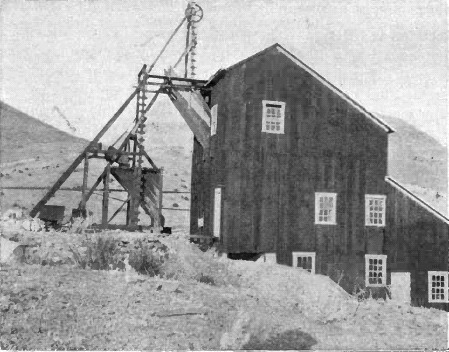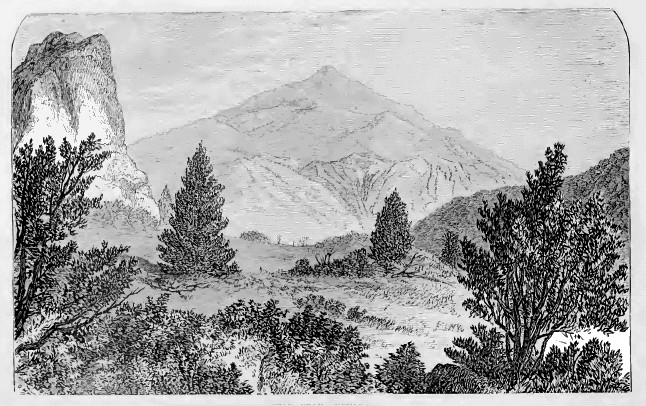Nevada Copper Mines:
Nevada has long been an important producer
of copper ores. Production has come from a number of locations.
Ely, Nevada.
This district has long been of great importance, both as a copper and
gold producer. The copper belt, which lies 6 miles west of
Ely, in White Pine County, is about one mile wide and six miles long
extending in an east-west direction. It lies in a pass through the Egan
Range, along what used to be a route
to Eureka, Nevada.
The Ely (Robinson) district, in eastern Nevada, is an area of Paleozoic
shales and limestones which are intruded by monzonite porphyry and locally
are overlain by Tertiary rhyolite. The section there involves the following
formations:
Ruth limestone
Arcturus limestone 1000 feet
Ely limestone, Carboniferous 1500 feet
White Pine shale 1000 feet
Devonian Nevada limestone 1000 feet
The sediments which have a gentle dip are cut by a coarse-grained quartz monzonite, which has effected only a limited amount of alteration in the adjacent limestone, producing some garnet rock and chalcopyrite. The sedimentary rocks near the porphyry intrusions are locally garnetized or changed to jasperoid and commonly charged with great quantities of pyrite. There are present also dikes of porphyry and rhyolite lavas, the latter resting on the uneven limestone surface, but these eruptives bear no genetic relation to the ore. Of importance in this connection are the monzonite intrusions, which carry ore. The ore, consisting of pyrite and chalcocite, is disseminated through the much altered and shattered monzonite porphyry and there is a sharp line of separation between the gossan and unoxidized bluish white rock containing the grains of pyrite and chalcocite. The oxidized zone on the average extends to a 190 to 280 feet has been determined.
Some of the copper ore bodies are of great size, that at the Ruth mine having a width of 50 to not less than 250 feet, and being developed for a length of not less than 900 feet. It is believed that the ore bodies have resulted from a leaching of secondary ores in the oxidized zones and that the only primary ore now known is the chalcopyrite in the garnet rock occurring beneath the quartz "blow outs." These latter are masses of quartz occurring mainly along the contact, and formed by the replacement of both limestone and porphyry with silica which was leached out of the porphyry by carbonated waters. The low-grade-ore body of significant tonnage at the open pit at
Ruth, Nevada, owes its commercial grade to surface leaching and enrichment of the ore below with secondary sulfide. In places near the igneous masses considerable amounts of chalcopyrite occur with the pyrite. Galena and its oxidation products occur in irregular lodes within the metamorphic area, principally at some distance from the porphyry masses. Gold ores with lead carbonate occur mainly as blanket lodes. Copper deposits replacing limestone have recently been discovered. These contain 10 per cent, copper. Of many superficial showings of copper carbonates none have been developed profitably, but oxidized copper ores of relatively high grade have been discovered in the Alpha mine, at considerable depth. The principal deposits are the disseminated supergene ores in porphyry mined by the Nevada Consolidated Co. These deposits lie like a blanket with an average thickness of 218 feet and contain over 60,000,000 tons of ore carrying 1.7 per cent, of copper. They are capped by a mantle that has an average thickness of 103 feet, which carries only 0.05 per cent, of copper. Below the ore body the sericitized porphyry primary ore carries only 0.4 per cent, of copper.
The principal production has been from a large mass of pyritized monzonite carrying a significant copper content. The copper minerals are mainly chalcopyrite with lesser amounts of chalcocite. Early copper mining in the district was restricted to supergene-enriched ores. According to Pennebaker, the bulk of production in recent years has come from the primary pyrite-chalcopyrite ores. The large size, uniform character, and shallow depth of the ore bodies make ideal conditions for the open-pit and block-caving methods of mining. The low mining cost per ton by these methods and the high recovery by concentration of the ore by flotation, has made possible profitable large-scale operations. Without these conditions favorable to low operating costs, only selected portions of the ore could have been mined, and the production from such operations would have been far short of its present magnitude. The copper ores have been worked mostly as open cuts, and the average copper content of those mined in 1914 was 1.483 per cent.
Yerington, Nevada: A number of copper mines located in Lyon County near Yerington have been important copper producers. These contact-metamorphic deposits of western Nevada have been economically important as sources of copper, but have produced only minor amounts of other metals. The only important copper production in this area has been from deposits of this type in the Yerington and Santa Fe districts. Most of the production from the Yerington district was derived from primary sulfide ores. The profitable ores of the Santa Fe district in Mineral County were limited to small supergene-enriched bodies in the upper parts of the deposits.
Generally the copper and zinc content of ore bodies containing those metals has been leached out of the oxidized zone which accounts for many barren outcrops above bodies of copper and zinc ore; but if the ore contains calcite or is in limestone, the copper and zinc content is precipitated out in great part as the carbonates in the oxidized ore at or near the surface. In the case of both silver and copper ores much or all of the metal may be dissolved out of the oxidized zone and re-precipitated as a sulfide near the water level. The one of the most striking examples in Nevada of this enrichment is the case of copper is at the Ludwig mine in Lyon County. Thousands of tons of rich, almost jewelry grade ore of malachite and azurite, containing chrysocolla also, were shipped directly to the smelter. Below this, the ore was rich cuprite and native copper ore, and below this at water level was secondary chalcocite, then below this was a primary chalcopyrite copper ore too low grade to be profitably mined.
Rio Tinto, Elko County In the early 1930s, the Mountain City district became a sudden producer of rich copper ores. At the Rio Tinto mine in the Mountain City district in Elko County the leaching out of the copper in the oxidized outcrop was practically complete, with a remarkable secondary sulfide enrichment near water level that has been responsible, as direct shipping ore of over 20% copper content, for a large share of the mine's copper production. In the case of copper ore, the copper is precipitated as the sulfide chalcocite. This secondary sulfide along with the primary copper sulfides often gives a total copper content approaching bonanza ore.
In 1926 S. Frank Hunt, an experienced student of geology, began work on a barren limonite outcrop in the Mountain City district in Nevada. Situated three and four miles south of town, Hunt believed the Nevada Rio Tinto and monzonite claim groups on two wide copper veins presented an opportunity of unusual promise. Fortified by his almost solitary faith in his judgment, he struggled for six years amid hardships to push a shaft down through the leached outcrop before finally encountering, in February 1932, the secondary enrichment at 228 feet in the shaft, being within a few feet of his estimated depth to water level.
On February 28, 1932, he wrote: "At noon on the 26th at 228 feet deep in the shaft we uncovered the sulfide zone. Tonight at 234 feet the whole bottom of the shaft is in solid, good, ore-nearly all pure copper glance and high grade. From present appearances and from what we know about the magnitude of the Rio Tinto vein, it is most likely the biggest deposit of high grade copper - gold ore ever discovered in Elko County." The discovery was made beneath 225 feet of remarkably barren goethite gossan. As an example and study of weathering and secondary enrichment, Rio Tinto is unsurpassed in the Great Basin Region.
The development of the mine may have proved some of his early conceptions about the geology somewhat faulty, but its production to 1944 of over $20,000,000, in great part from the zone of secondary enrichment, has justified his prophesies and given a great stimulus to the study and development of leached outcrops. It is interesting to note that the vigorous exploration work on other leached outcrops in the Mountain City districts since Mr. Hunt chose the Rio Tinto for development have failed to find the expected secondary enrichment of copper.
Return To: Copper Ore Deposits of the USA


